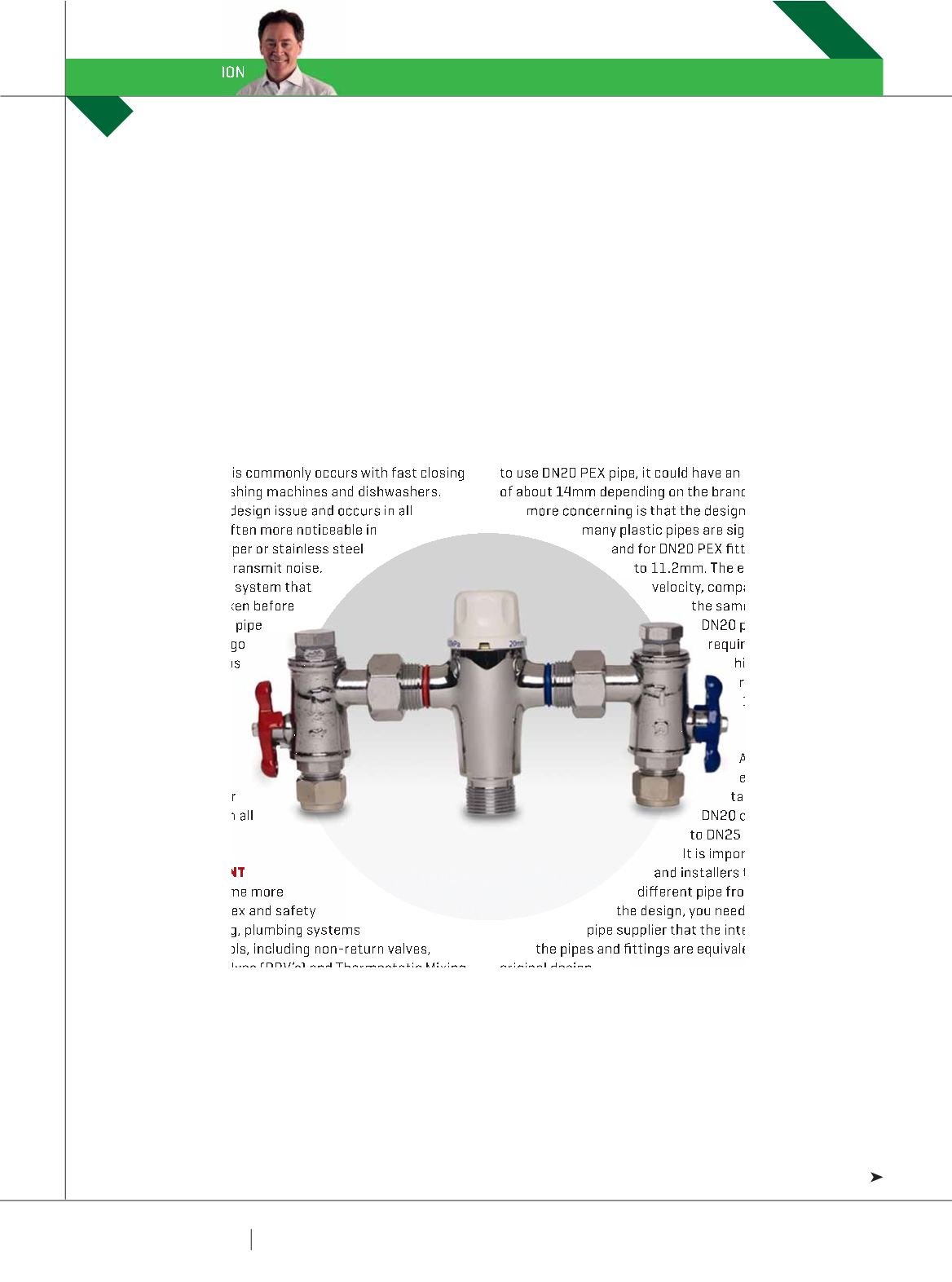

7 0
PLUMBING CONNECTION
WINTER 2016
A SOUND INVESTMENT
W
ith more complicated plumbing designs required
to incorporate safety and energy saving
equipment it is even more important to correctly
design the plumbing system in order to eliminate the
possibility of noise occurring throughout the system-either
due to the flow of water or water hammer.
Water hammer is the pressure surge or shock wave
caused when a fluid in motion is forced to stop or change
direction suddenly. This commonly occurs with fast closing
solenoid valves on washing machines and dishwashers.
Water hammer is a design issue and occurs in all
pipe systems, but is often more noticeable in
metallic pipes like copper or stainless steel
due to their ability to transmit noise.
The noise is a warning system that
allows action to be taken before
damage is done or the pipe
bursts, but can often go
unnoticed until obvious
problems occur.
But it’s not only
water hammer where
noise can be an issue.
High water velocities,
damaged tap washers
and poorly designed or
installed plumbing can all
create noise.
THE SILENT TREATMENT
As appliances become more
technologically complex and safety
regulations keep rising, plumbing systems
need additional controls, including non-return valves,
Pressure Reducing Valves (PRV’s) and Thermostatic Mixing
Valves (TMV’s) that act to protect both the people using the
system and the system itself. If the correct size pipes are
used and the system is at the correct pressure then they
should have no influence in the system.
There are complicated equations for calculating the effect
of water hammer but the key parameters are pressure and
water velocity through the pipes. If smaller pipes are used
the water has to travel faster to obtain the same flow at the
outlet.
One of the most common mistakes when installing
plumbing is not using the material or size specified in
the design. This may be due to a number of reasons like a
lack of knowledge or availability of materials, but keeping
costs down is often the most common. Most Hydraulic
Consultants use design principles based around copper
plumbing when calculating water usage, flow, velocities and
pipe sizing.
If a design specifies DN20 copper pipe then this has an
internal diameter of about 17mm. If the installer decides
to use DN20 PEX pipe, it could have an internal diameter
of about 14mm depending on the brand and type. What is
more concerning is that the design of the fittings for
many plastic pipes are significantly smaller
and for DN20 PEX fittings it can be down
to 11.2mm. The effect on the water
velocity, compared to copper for
the same flow, is that for the
DN20 plastic pipe it would
require a velocity 47%
higher but the fittings
requires an additional
130% (2.3 times)
the velocity. (Note:
AS/NZS 3500.1 and
AS/NZS 3500.4 have
equivalent pipe size
tables and specify that
DN20 copper is equivalent
to DN25 PEX.)
It is important for plumbers
and installers that, if using a
different pipe from that specified in
the design, you need to check with the
pipe supplier that the internal diameters of
the pipes and fittings are equivalent or larger than the
original design.
The other contributing factor for noise and water hammer
is pipe supports. All pipes have a specified maximum
spacing for brackets and clips as listed in AS/NZS 3500.1
and AS/NZS 3500.4. Copper and steel pipes require less
clipping due to their rigid nature. Plastics require more
clipping but many plumbers fail to correctly install plastics
and these can float and bang on the walls when there is a
pressure surge or water hammer.
RISING ISSUE
There’s been an increase in the number of noise issues
TAKING THE TIME TO INSTALL A WELL-DESIGNED PLUMBING SYSTEM HAS ALL SORTS OF PAYBACKS, BUT NO NOISE
IS ONE OF THE BEST FOR EVERYONE INVOLVED SAYS
JOHN FENNELL.
COPPER CONNECTION
JOHN FENNELL
TMVs act to protect both the people
using the system and the system itself.
















